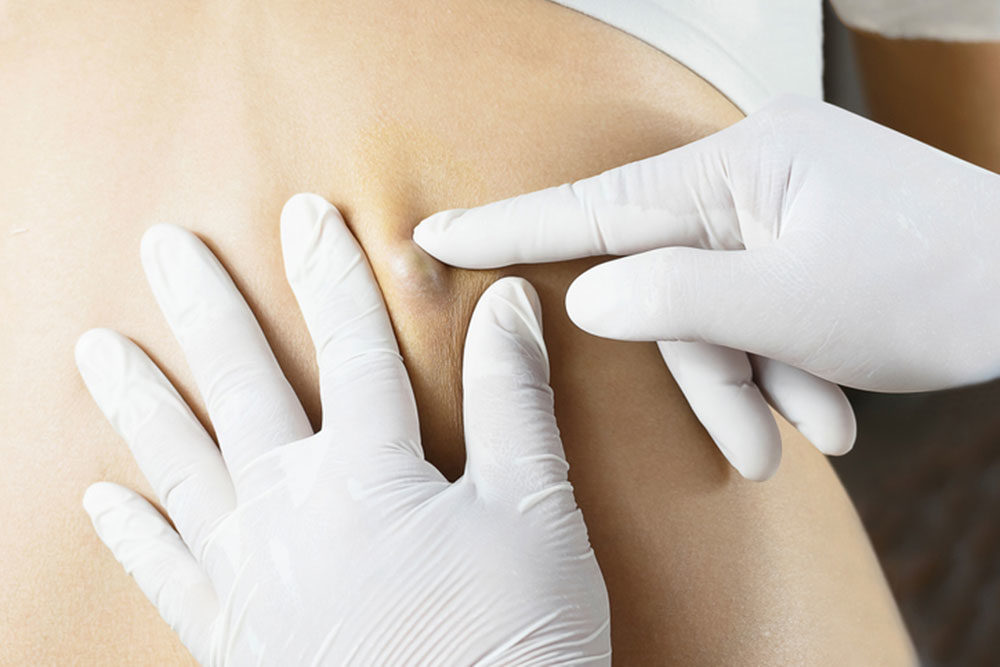
iStock
NEARLY IDENTICAL bumps on two adjacent fingers—which I was hoping the dermatologist could remove—were not the same thing, the P.A. told me. One was a cyst, for which I would need a hand specialist. The other was a wart, which she advised working on myself to remove with salicylic acid patches, despite my entreaties for the cryosurgery that had so rapidly removed my kids’ warts years ago.
Cysts and warts can appear similar and both come in dozens of varieties that are grouped based on appearance and location. Both often resolve with no intervention. Both carry a small risk of cancer: warts, when the virus causing them is one of the few high-risk strains; and cysts, if the cells inside them are cancerous.
Cysts are abnormal capsules or sacs that occur within tissue and are usually closed and separated from nearby tissue by a distinct membrane. A cyst fills with liquid or gaseous material— like a blister—or pus, which makes it an abscess.
Cysts can vary in size from microscopic to large enough to displace internal organs, in which case doctors can remove them surgically. Most “live in” in the skin, ovaries, breasts or kidneys.
Two kinds of cysts occur beneath the skin. A sebaceous cyst is filled with the oily substance called sebum, secreted to lubricate the skin—which can build up inside a pore or hair follicle. An epidermoid is created when surface skin cells move deeper into the skin and fill with soft, yellowish keratin. (When I had a sebaceous cyst that occasionally became red and enlarged, I asked the dermatologist to remove it before a long trip to southern Africa where I wanted no extra health risks.)
Ovarian cysts are most often benign, although some grow large enough to make a woman appear pregnant. While ovarian cysts are less common before menopause, up to 18% of women will have one at some point, and a small percent of these will become cancerous.
Baker’s cysts create a bulge and feeling of tightness behind the knee, most often causing pain when extending the knee or during exercise. They’re usually caused by joint problems like arthritis. Pilar cysts form from hair follicles, most commonly in the scalp. When cysts arise due to a chronic medical condition, like fibrocystic breast disease or polycystic ovary syndrome, that condition becomes the focus of treatment.
Warts, by contrast, are small tumors on top of the skin caused by the human papilloma virus (HPV). Ranging from very light colored to very dark, they are usually painless but can cause burning and itching. Different types include common warts, usually on the fingers; plantar warts on the soles of feet; flat warts that occur where you shave; and genital warts.
HPV triggers the growth of extra cells that develop their own blood supply and nerves. The virus is contagious—passed when skin is shed directly onto another person or onto a floor or carpet. Although warts can spread through sexual contact, most are passed via casual contact or shared objects like towels. Untreated warts can last about two years until the skin recognizes the virus and begins fighting back.
The HPV vaccine Gardasil—usually given to people ages 9 to 26—prevents many kinds of warts and, importantly, prevents most cancer that can be caused by some strains of HPV. In adults, warts are worrisome only when they appear suddenly, possibly signaling immune system malfunctioning; otherwise, by adulthood, most people have developed immunity to the virus.
To remove warts, dermatologists usually recommend salicylic acid, but a reportedly easier and more effective remedy involves duct tape. You cover the bump for six days, and then on the seventh day remove the tape, soak, and remove dead skin with an emery board. Other options include lasers, freezing and surgery.
For my cyst, an orthopedic hand specialist recommended aspirating the fluid with a needle, which was unexpectedly painful. In the months afterwards, the cyst became infected and required surgical removal, for which I waited a little too long and lost some function in the adjoining tendon.
At a subsequent dermatology visit for a whole-body exam, after months of using salicylic acid on the wart to no avail, I asked again about cryosurgery. But when the P.A. gave that bump a second look, she switched the diagnosis: It’s a cyst and needs a repeat visit to the hand doctor. Now I’m waiting for real trouble before starting down that road again.
—Mary Carpenter
Every Tuesday in this space, well-being editor Mary Carpenter reports on health news you can use.

I had no idea that you can take care of your body’s warts by having them frozen and removed to prevent itching. I heard the term wart freezing from one of the shows I watched last week. I should share this with my friend, who’s annoyed by warts on her feet.
Thank you! Very informative and, per usual, some excellent practical tips for addressing these annoying problems. I didn’t realize that all warts were caused by HPV. Yet another great reason for all kids to be vaccinated before pesky warts develop.
Oy. Thank you though.